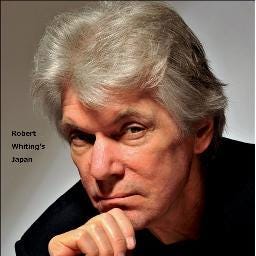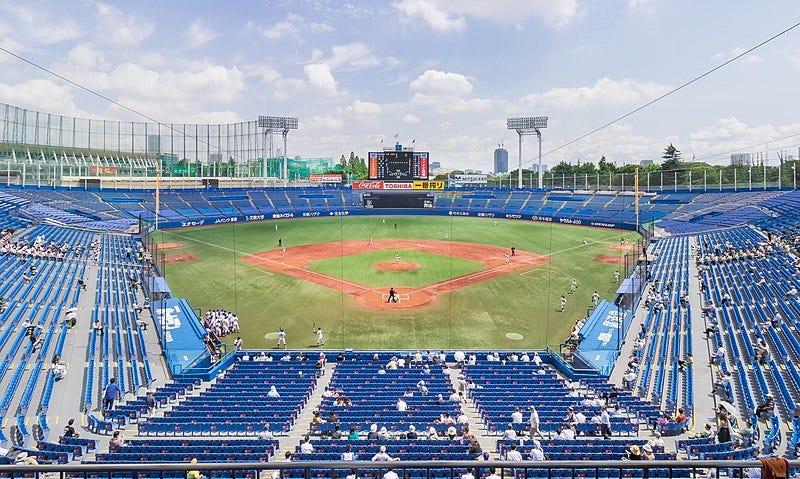Razing Jingu Stadium not a good idea
TOKYO — I like Meiji Jingu Stadium. I have been going there on and off since the 1960’s when there were no seats in the outfield, just a grassy slope where you could sit and watch the game, spread out a blanket, drink beer and look at the sky between innings.
I would go there to watch the Toei Flyers with Isao Harimoto when that Pacific League team was based there. I remember watching Daryl Spencer of the visiting Hankyu Braves hit long home runs there. I watched the old Yakult Atoms line up before the stands in the infield, during one season, bow in unison and apologize for losing 12 games in a row. I watched the Swallows win their first pennant and Japan Championship in 1978. I watched a Keio-Waseda game there once with Professor Masaru Ikei. I interviewed Bob Horner in the Jingu clubhouse.
I liked Jingu Kyujo even when it was old and decrepit with the most foul and smelly toilet in all of Asia. I liked it even more when it was renovated. I loved watching the umbrella oendan in right field after spectator seats were installed. In 2013, I saw Vladimir Balentien break Sadaharu Oh’s single-season home run record of 55 there, finishing up with 60, thanks to a juiced ball.
Jingu Kyujo has a sense of history, dating back to 1926. It is one of the four stadiums still standing where Babe Ruth played (the other three are Koshien Stadium, Wrigley Field in Chicago and Fenway Park in Boston). It’s one of the best places to watch baseball in Japan, in my opinion, with its view of the evergreen trees beyond the outfield.
I liked the whole environment of the area, completed in 1920, as a tribute to the Emperor Meiji — the historic shrine, the evergreen forest, the stately gingko tree-lined avenue, several dozen hectares in all. It is an oasis of peace and tranquility in the middle of a noisy, crowded city (except on New Year’s Eve when the crowds are crushing). The Meiji Memorial Picture Gallery is a national treasure. The Memorial Hall is a place of national pride. The varied sports facilities — National Stadium, Chichibunomiya Rugby Stadium, Jingu Kyujo are always in use.
Now the whole place is at risk. In 2019, Jingu Stadium ownership, the Japan Sports council, Mitsui Fudosan and Itochu jointly finalized a plan to redevelop both Jingu Kyujo and nearby Chichibunomiya Rugby Stadium. Under this plan Meiji Jingu will be demolished and rebuilt on the site of the rugby ground, while a new rugby stadium will be built on the site of the present Jingu Stadium.
Two high-rise buildings will also be erected, in conjunction with yet another shopping mall, with the project scheduled to be completed in 2036.
Also, 971 trees, or 70% of the area’s greenery, are to be felled — and perhaps transported for replanting elsewhere, but that’s not clear and maybe not even feasible.
Tokyo Metropolitan Government's City Planning Council — and Tokyo Governor Yuriko Koike — recently approved the planning area and framework, with the specifics of the project and construction will be decided in the future.
However, the plan does not seem to have been thoroughly vetted. The Tokyo Metropolitan Government released the details of the plan on Dec. 14, 2021, with a comment period of only for two weeks. Thus discussion with the public was minimal.
The Japan ICOMOS National Committee, an advisory body of the United Nations Educational, Scientific and Cultural Organization (UNESCO), has formally called for an urgent overhaul of the project to ”protect the urban heritage” of the area.
Rochelle Kopp, a Yale graduate and University of Chicago MBA, who heads the firm Japan Intercultural Consulting, has been leading an effort to stop the project, starting with a petition signed by 50,000 people and sent to Koike’s office, which the governor ignored.
Ms. Kopp, a longtime Tokyo resident, has cited a number of problems with the plan, which will change the iconic look of the area. They are as follows:
— All the sports facilities in the park that can be used by the general public, such as a softball field, golf driving range, futsal courts and batting center, are to be eliminated. The only sports facility to remain is an expensive membership-only tennis club.
— The planners have not explained why this project is in the public interest and why it is necessary and economically viable for the citizens of Tokyo. The Tokyo Metropolitan Government has apparently decided that the current baseball and rugby stadiums are outdated, but is this really the case?
— What is the point of switching the locations of the baseball and rugby stadiums? Is not renovation alone sufficient? Do we really need another large facility when the newly built huge national stadium is right next door? Are the opinions of baseball and rugby fans being reflected? There are many fans who feel attached to the current ballpark and stadium.
— Governor Koike has emphasized that the iconic four rows of ginkgo trees will be preserved, but the huge baseball stadium to be built will come very close to them, and it is feared that their roots will be damaged. Also, the exterior wall of the stadium will be right next to the ginkgo trees, which will drastically change the appearance of the area.
— Governor Koike's claim that the amount of greenery will be increased is a complete deception, says Kopp. In the plan, lawns and low plantings are considered equal to trees that have lived for 100 years. Although the simple square footage of greenery may be going up, the volume of greenery is going down.
— There is not enough concrete data or explanation of the projected environmental impact of this redevelopment. It is clear however that increasing the number of skyscrapers and huge buildings and on top of that reducing the number of trees will result in huge CO2 emissions.
Summing up, Kopp says: “To say that this is a reckless plan riddled with problems is an understatement. It is incredible that such an outrageous plan has been approved. But there is still the possibility to get it changed if we as citizens speak up loudly enough. We need to raise our voices and not give up!”
I tend to agree with Kopp and ICOMOS. I don’t understand how or why this plan was allowed to continue to this point without any public involvement, but I am happy to see the public getting involved now.
I especially don’t understand the need to move Meii Jingu from its present location and replace it. Chicago managed to renovate historic Wrigley Field (opened in 1914). Boston managed to redo ancient Fenway Park (opened in 1912) without moving it down the street. Koshien and Miyagi Stadiums were similarly rebuilt. Why can’t Tokyo do the same? Is this just another money-making scheme?
If you want to participate, you can sign the petition at this link:
https://www.change.org/p/protect-jingu-gaien-s-trees-rethink-the-development-plan



